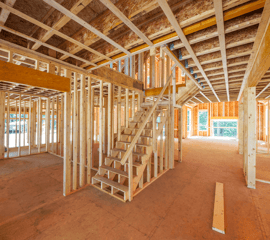 In Part 1 of our Process series, we walked you through the first, pre-construction steps of crafting your new home, including paperwork and design selections.
In Part 1 of our Process series, we walked you through the first, pre-construction steps of crafting your new home, including paperwork and design selections.
Now it's time to construct your new home.
Let's take a basic, overall look at these next steps.
 Your Site Superintendent
Your Site Superintendent
The construction of your home is by far the most in-depth part of the process for obvious reasons. Your site superintendent acts as your general contractor for the duration of the build and handles quite a substantial amount of tasks.
He or she will be the main point of contact for everyone involved in your home's construction, from trades to municipality inspectors. He or she will also liaise with the main office and with your sales agent to coordinate your build. Your site superintendent will also be the person who does your construction walk-throughs at certain points during the build.
Stake Date and Excavation
Once all of the paperwork and permits have been issued and approved, your construction team will schedule out your stake date and your construction will be officially underway. Your stake date is the date a preferred surveying company comes out to mark the placement of your home within your lot. These stakes are guidelines for the excavators to know where to dig the hole for your foundation.
This is an important stage you'll want to pay close attention to, as product quality matters in a home foundation.
Within a few days of staking your lot, excavation will take place. Excavators dig the perimeter of your home's foundation plus a few feet of extra width to accommodate for installation of the drainage system (weeping tile). They also dig to the depth or depths marked by the surveying company.
Footings and Foundation
Once your hole has been excavated, it's time to pour footings and foundation. Your footings are a section of special concrete on which your foundation and all structural support will be situated. You'll see footings around the perimeter of your home's foundation, but you'll also see footings poured to support your staircase and any basement teleposts you'll have.
Once your footings are complete, your foundation can be poured. This begins with the installation of special forms that your foundation concrete will be poured into. These forms help shape the walls of your foundation and ensure they cure in the right position. Your footings and foundation are subject to municipal inspection and must pass prior to framing.
 Framing
Framing
After your foundation has been poured and cured, your home's main and upper floors (if applicable) will be constructed by a framer. The framer builds the exterior and interior walls of your home and is responsible for ensuring its structural integrity. As such, framing is subject to a municipal inspection as well. Framers also install your windows and doors as the last stage before their work is complete.
Utility Installation
Once your home has been framed, electrical, plumbing, and HVAC services will be installed in your home. All three of these services are also subject to municipal inspection to ensure their proper operation, and that they did not interfere with the structural integrity of the home.
At this point in the construction process, you'll experience your first walk-through on your home to show you the "bones" before drywall covers everything up. Now is the time to voice any concerns you have, as it's far easier to repair now than forcing a renovation down the line.
About this time, your exterior finishes will be installed such as siding, stucco, stone, and any painting required. We should note, however, that paint is a seasonal item as the temperature has to be right so this may not happen immediately.
Insulation and Vapour Barrier
After your utilities have all passed inspection, insulation and vapour barrier will be installed in your exterior walls and roof attic. The vapour barrier prevents temperature differences between the inside and outside from creating condensation inside your home, which can lead to mould.
Different types of insulation are used depending on the location of its installation (such as the attic, walls, etc.) to ensure maximum energy efficiency in the home. Typically, you'll find blown-in insulation in attics as it's easier to fill the angled voids that naturally occur, while exterior walls will either have batt insulation, Roxul, or spray foam. Ceiling voids in overhangs — such as over a verandah — may also have spray foam.
Drywall, Priming, and Texture
After everything inside your walls and ceiling is complete, it's time to cover them up with drywall. This is where your spaces begin to visually take shape and the process gets even more exciting. Drywall will be mudded and taped to ensure smoothness at the joints, and a prime coating will be applied to the surfaces so your paint colour is smooth. At this time your ceiling texture will also be installed.
Off to the Races
Well, it's not really a race. However, at this stage of the game, it appears that way as many different things seem to happen at once. Your flooring underlay will be installed (for tile and hardwood flooring), and then your cabinets will be installed in your kitchen and bathrooms.
Your trimwork, countertops, flooring, and any interior stonework will be completed at this time, as well as wall paint. It's hard to not want to visit your home every chance you get at this stage since, every day, it will look more and more like the home you designed and imagined.
Pre-Occupancy Walkthrough
The final stage before you take possession of your new home is to do a final walkthrough of your home with your Site Superintendent. He or she will guide you through your home, show you the working parts and how to maintain them, and hear any concerns you have. This appointment takes place approximately one week prior to possession, so your home should be at least 99% complete at this stage.
Seasonal Items
On your possession day, depending on the time of year, you may have some seasonal items incomplete on your home. Concrete is extremely weather-dependent, and you may or may not have walkways and your driveway as a result. Exterior paint is also subject to weather, so you may still have some items that will have to wait for better weather to complete.
This overview is extremely basic, but it gives you a good idea of the average timeline of when certain tasks take place. For further detail, please feel free to consult with a sales agent, and when your home is under construction, we hope you enjoy every moment watching it grow.
 Photo credits: construction, carpenter, framing
Photo credits: construction, carpenter, framing



